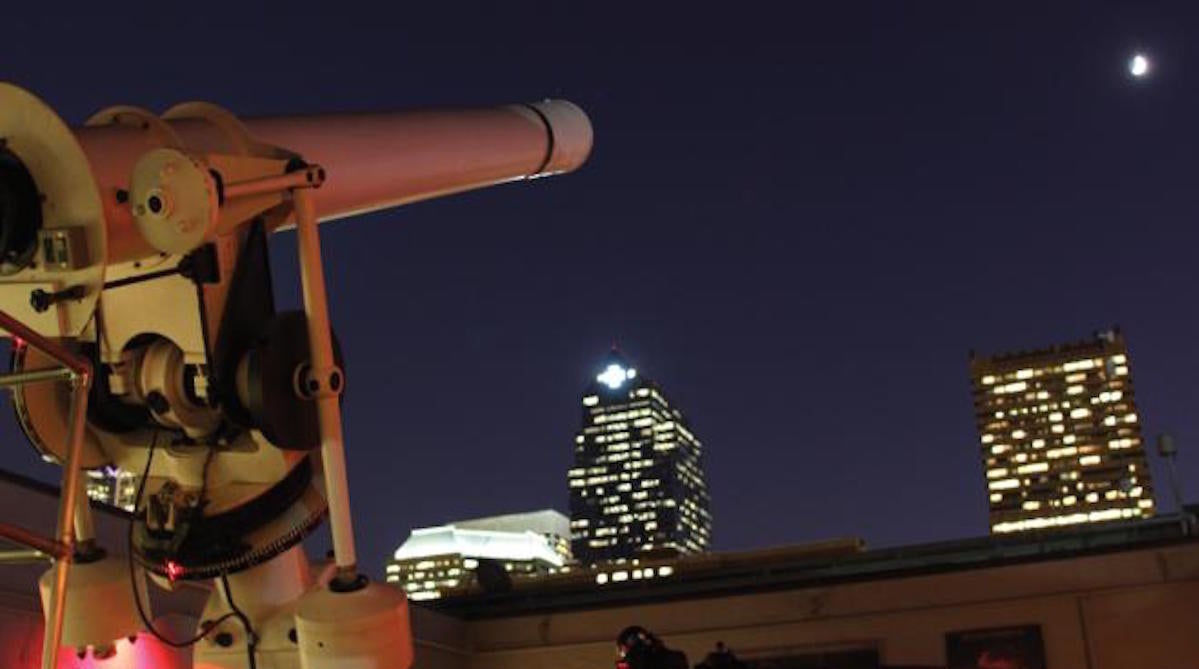I was over the moon to go stargazing with my son

(Courtesy of the Franklin Institute)
“What’s a spring fever?” my 5-year-old daughter recently asked as she contemplated our backyard Magnolia tree that was bursting into bloom.
I was ecstatic that the days were already trying on the shimmery feel of summer. And when a friend suggested taking our third-grade sons and some of their friends to the Night Skies in the Observatory at The Franklin Institute, I readily assented. The outing sounded full of warm promise.
I had existed for more than 44 years on this earth without ever peering at planets through a telescope —much less through a 10-inch Zeiss refractor or a Celestron CPC 800 GPS computerized one.
“Do you want to see outer space with your buddies tonight?” I asked my 9-year-old son.
He shrugged an OK, not quite grasping the celestial serendipity of a clear, 75-degree Philadelphia evening in early March and a mother so long smothered by winter that she was willing to take him out late on a school night.
So down the Schuylkill I steered our minivan from Bala Cynwyd to Center City Wednesday evening after dinner. When I saw the crowds already gathering inside the museum, however, I started to regret that we hadn’t bolted our food even faster than usual.
“I’m sorry,” the man at the desk said. “We’re sold out.”
“But my son will be so disappointed,” I lied, nodding toward Griffin, who was staring into a closed ice cream bin while he waited for his friends.
After I agreed to renew our expired membership, the clerk finally handed over tickets, and my son perked up as soon as his classmates appeared. Then they immediately started alienating everyone around us by resuming the boxing match they’d left off at recess.
I felt my fantasy of a peaceful night’s stargazing begin to ebb as my friend and I trailed after the boys into the Institute’s Space Command exhibit, where they darted past the display of an actual Moon Rock toward a computer where they constructed digital rovers to battle each other on imaginary Martian terrain.
I had heard that the observatory had live feeds of actual footage from Mars but was having trouble luring our kids away from their virtual outer space. We were missing the Fels Planetarium show and an astronomical lecture — appropriate, the literature said, for ages 8 and up. The boys didn’t care.
But when they started pelting each other with hard little spheres from the Gravity Well, I had finally had enough.
“We’re going up,” I commanded, trying to sound as imperious as a cosmonaut.
I was crestfallen, however, to see a long line of college students, there to earn credit for class, snake its way down the corridor from the doors opening into the night sky.
“We should have come up earlier!” my fellow mother wailed.
“Can’t we go get some ice cream?” Griffin complained. “I saw some downstairs.”
“We’re here to look at planets,” I insisted, growing doubtful that we ever would as the queue inched forward along with the minute hand on my watch.
Needless to say, I was relieved when an older woman walking toward us read the despair in my expression.
“There’s no line for the smaller telescope, and you see the same thing,” she leaned in and whispered.
Forfeiting my dream of huddling over the 10-inch Zeiss — whatever that was — I started pushing forward. Sure enough, only a couple of people stood waiting to look into the 8-inch Schmidt-Cassegrain telescope that was dwarfed by the nearby Zeiss but that a volunteer had nonetheless trained on Jupiter and its four largest moons.
I watched as he swiveled my son’s chin into position and covered one of Griffin’s eyes to enhance his view. From my son’s tepid response, I’m not sure he even saw the planet.
But I did. And it was amazing, a glowing orb surrounded by four bright pinpricks of light.
“Weren’t you afraid you’d get pink eye?” a friend asked the next day when I told her about peering into the Schmidt-Cassegrain.
But neither my son’s irritating antics nor my own OCD tendencies could dampen my excitement at having actually spied Jupiter and its moons from a rooftop in Philadelphia — an ethereal experience that lifted my spirits out of their long winter’s sleep into the warm night’s air.
The next Night Skies event at The Franklin Institute is from 7-10 p.m. on April 14.
The Strawbridge Observatory at Haverford College also has telescopes available for public use.
WHYY is your source for fact-based, in-depth journalism and information. As a nonprofit organization, we rely on financial support from readers like you. Please give today.

